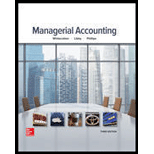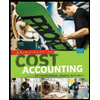
Briefly describe the five steps of the management decision-making process.
A decision can be characterized as a strategy which is intentionally browsed through a lot of choices to accomplish authoritative or administrative destinations or objectives. Decision making process is consistent and an essential part of dealing with any association or business exercises.
To discuss:
Brief definition of the five steps of decision-making process.
Answer to Problem 1Q
There are five steps of decision-making
- Identifying the decision problem
- Determining the decision alternative
- Evaluating the costs and benefits of the alternative
- Making the decision
- Reviewing the results of the decision.
Explanation of Solution
There are five steps of decision making
- Identifying the decision problem A standout amongst the best decision making procedures is to watch out for your objective. This basically implies distinguishing the motivation behind your decision by asking yourself what precisely is the issue that should be tackled? Also, for what reason should this issue be fathomed?
- Determining the decision alternative While gathering data, it is ideal to make a rundown of each conceivable option, even those ones that may at first seem senseless or appear improbable. the conclusions of individuals that you trust, or address specialists and experts should constantly be looked as it will assist you in coming up with an assortment of arrangements when gauging every one for your choices as an official choice.
- Evaluating the costs and benefit of the alternative This is a fundamental advance since it enables you to survey the advantages and disadvantages of the distinctive alternatives that you recorded in the past advance. It is additionally significant because you would want everyone to feel good about your choices and the conceivable results of whichever one you pick.
- Making the decision Since you have recognized your objective, accumulated all the vital data, and gauged the results, the time has come to settle down on a decision and execute your official choice. Understanding that this progression can cause a few people a ton of tension is significant on the grounds that this is the place you need to heed your gut feelings.
- Reviewing the result of the decision.
When you have settled on your ultimate choice and placed it without hesitation, it is important to assess the decision and the means you have taken to guarantee that it works. This last advance is as significant as stage one, if not increasingly significant, because it will assist you with further building up your decision-making abilities for future issues. This progression is a key since it might be expected from you to search out new data and roll out certain improvements en route.
Want to see more full solutions like this?
Chapter 7 Solutions
Managerial Accounting
- Boca Inc. Balance Sheets December 31 Assets Cash Accounts Receivable Inventory Prepaid Expenses 2022 2021 110,800 48,400 38,000 87,800 112,500 102,850 26,000 28,400 Long-term investments 109,000 138,000 Plant Assets 397,000 242,500 Accumulated depreciation 50,000 52,000 Total 743,300 595.950 Liabilities and Stockholders' Equity Accounts Payable 72,000 67,300 Accrued Expenses Payable 13,500 21,000 Dividends Payable 3,000 Bonds Payable Common Stock 170,000 146,000 262,000 175,000 Retained Earnings Total 222.800 186.650 243,300 595.950 Additional Information: 1. Old plant assets having an original cost of $57,500 and accumulated depreciation of $48,500 were sold for $1,500 cash. 2. A new plant asset was purchased directly in exchange for common stock valued at $42,000. 3. New bonds were issued at par for $60,000. 4. 2022 Net income was $154,480. 5. A $1,000 prior period adjustment was recorded in 2021 correcting an understatement of depreciation in 2019. The 2021 balance sheet is…arrow_forwardPlease explain the solution to this general accounting problem with accurate explanations.arrow_forwardNathan Industries applies overhead using a normal costing approach based on direct labor-hours. The budgeted factory overhead was $480,000, and the budgeted direct labor-hours were 12,000. The actual factory overhead was $492,500, and the actual direct labor-hours were 12,750. How much overhead would be applied to production?arrow_forward
- Please provide the solution to this general accounting question using proper accounting principles.arrow_forwardAfter the year-end adjustment, what is the net realizable value of accounts receivable?arrow_forwardVantage Components, Inc. determined at the beginning of the year that estimated overhead costs would be $650,000, and the estimated allocation base would be 65,000 direct labor hours. By the end of the year, actual overhead costs totaled $698,000, and actual direct labor hours worked were 68,500. What was the dollar amount of underallocated or overallocated manufacturing overhead?arrow_forward
- Principles of Accounting Volume 2AccountingISBN:9781947172609Author:OpenStaxPublisher:OpenStax College
 Managerial AccountingAccountingISBN:9781337912020Author:Carl Warren, Ph.d. Cma William B. TaylerPublisher:South-Western College Pub
Managerial AccountingAccountingISBN:9781337912020Author:Carl Warren, Ph.d. Cma William B. TaylerPublisher:South-Western College Pub Financial And Managerial AccountingAccountingISBN:9781337902663Author:WARREN, Carl S.Publisher:Cengage Learning,
Financial And Managerial AccountingAccountingISBN:9781337902663Author:WARREN, Carl S.Publisher:Cengage Learning,  Cornerstones of Cost Management (Cornerstones Ser...AccountingISBN:9781305970663Author:Don R. Hansen, Maryanne M. MowenPublisher:Cengage Learning
Cornerstones of Cost Management (Cornerstones Ser...AccountingISBN:9781305970663Author:Don R. Hansen, Maryanne M. MowenPublisher:Cengage Learning Managerial Accounting: The Cornerstone of Busines...AccountingISBN:9781337115773Author:Maryanne M. Mowen, Don R. Hansen, Dan L. HeitgerPublisher:Cengage Learning
Managerial Accounting: The Cornerstone of Busines...AccountingISBN:9781337115773Author:Maryanne M. Mowen, Don R. Hansen, Dan L. HeitgerPublisher:Cengage Learning Principles of Cost AccountingAccountingISBN:9781305087408Author:Edward J. Vanderbeck, Maria R. MitchellPublisher:Cengage Learning
Principles of Cost AccountingAccountingISBN:9781305087408Author:Edward J. Vanderbeck, Maria R. MitchellPublisher:Cengage Learning





